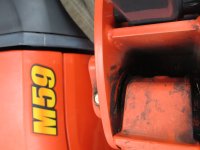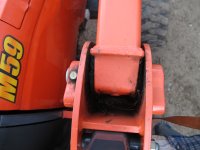5030
Epic Contributor
- Joined
- Feb 21, 2003
- Messages
- 24,644
- Location
- SE Michigan in the middle of nowhere
- Tractor
- Kubota M9000 HDCC3 M9000 HDC
But the unknown factor is what will cause the pin or any pin to fatigue and shear eventually and that is... How much clearance there is between the outer bosses on the loader frame and the pivoting point on the loader that the pin fits through. That is the 64 dollar question, shall; we say....
If the pivoting part of the loader that the pin fits through is small in length to the point of being excessive, failure will occur and thats what none of us actually know. I do know on my big Kubota's the boss to pivot fabrication spacing is minimal, about 3/32" on each side. Excessive spacing will cause failure every time.
BTW, a Grade 5 will yield (plasticize) more in respect to elongation that a Grade 8. I happen to be in the alloy steel business, thought in flat rolled high strength not fastneres but a quick look at the ASTM specification will bear that out.
If the pivoting part of the loader that the pin fits through is small in length to the point of being excessive, failure will occur and thats what none of us actually know. I do know on my big Kubota's the boss to pivot fabrication spacing is minimal, about 3/32" on each side. Excessive spacing will cause failure every time.
BTW, a Grade 5 will yield (plasticize) more in respect to elongation that a Grade 8. I happen to be in the alloy steel business, thought in flat rolled high strength not fastneres but a quick look at the ASTM specification will bear that out.

